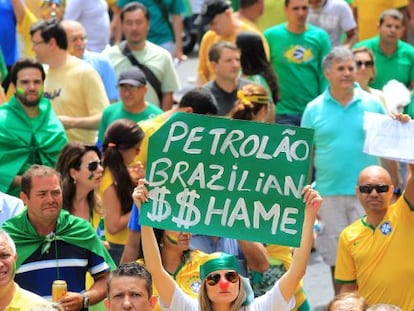Austerity and corruption place Brazilian leader in a lonely corner
Widespread anti-government marches show how Rousseff's popularity has fallen


In Monday’s edition of the Folha de São Paulo daily, a political cartoon by Jean Galvao shows President Dilma Rousseff standing alone in a dark corner of her presidential palace, and looking angrily out of a window as she counts, one-by-one, the number of people who took part in Sunday’s anti-government protest march.
The cartoon accurately depicts the Brazilian leader’s current situation: with less political support than ever, she is finding herself more and more isolated at the Palácio da Alvorada.
Rousseff’s approval rating has reached its lowest point since 2011, when she was first elected president
On Sunday, hundreds of thousands of Brazilians took to the streets across major cities, and the cry of “Dilma, get out!” was heard all around. Police estimate that a million people took part in the march in São Paulo alone; others say that two million poured out on to the streets across Brazil.
Regardless of the actual numbers in the turn-outs, Rousseff’s approval rating has reached its lowest point since 2011, when she was first elected president. One poll taken before the demonstrations showed that only 23 percent of people interviewed thought she was doing a good job in the more than three months of her second term.
“I am president of all Brazilians. We need to hear and talk to the people but we also need to remain committed to what we consider essential, such as the fight against corruption and fiscal austerity,” Rousseff said on Monday during an official ceremony.
While she maintains that it was important for the government to “listen to what they are saying in the streets,” many analysts and experts believe the president has little room to negotiate. Her list of allies, with the exception of her closest aides and ministers, grows shorter by the day.
Even in her own Workers Party (PT), the voices of dissent are becoming louder. Senator Walter Pinheiro, a pillar in the PT, has criticized the government for not acknowledging its mistakes and ignoring the society’s disenchantment with its policies.
Many other PT members are angry over Rousseff’s choice for economy minister: Joaquím Levy, the architect behind the government’s tax hikes and public-spending cuts.
The relationship between Rousseff and her biggest ally in Congress, the PMDB, is also on shaky ground
The relationship between Rousseff and her biggest ally in Congress, the Brazilian Democratic Union Party (PMDB), is also on shaky ground.
The PMDB speakers in both chambers, Eduardo Cunha and Renán Calheiros, were named in a list of more than 40 government officials and businessmen under investigation in connection to a multi-million dollar graft scheme at the state oil company Petrobras.
Some observers predict that the PT-PMDB alliance could break at any moment.
Someone who has been absent since the protests began is Rousseff’s mentor, former President Luiz Inácio Lula da Silva, who was a key supporter during her tough re-election campaign last year.
Lula da Silva and the current president have different characters, with powerful egos that sometimes collide
Trying to unravel how their complicated relationship works is like reading an endless chapter of contemporary Brazilian politics.
Lula da Silva, the founder of the PT, and the current president have different characters, with powerful egos that sometimes collide. Their trust in each other has also been questioned on occasion.
It used to be the PT mobilizing people on to the streets, but that is the past. There is a striking contrast between Sunday’s turnout – where at least one million showed up – and the 40,000 people who came to a rally on Friday organized by Rousseff.
Those who know the president describe her as a loner and distrustful, a person who is very unwilling to recognize her mistakes. They say she also tries to put a barrier between her and the rest of the world – a depiction that Galvao captured in that newspaper cartoon.








































